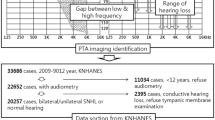Abstract
In this study 23 patients with noise-induced hearing loss (NIHL) referred for medico-legal evaluation and a group of 18 cases with Ménière's disease were evaluated audiologically using the middle-latency response (MLR). Cross-correlation functions were used to assess precisely MLR thresholds in low and middle frequencies. Cross-correlation data obtained from suprathreshold levels to below threshold levels were compared with the normal limits of parameters found at threshold levels, allowing us to determine the true MLR threshold. Our results revealed that this MLR threshold and visual detection thresholds were different in 18% of both the NIHL and Ménìere's disease groups. In this population the true MLR threshold was greater by 5 dB. These findings demonstrated that cross-correlation functions can enhance the sensitivity of the definition of the MLR threshold. True MLR thresholds were compared with subjective pure-tone audiometric (PTA) thresholds at the same frequencies (0.5, 1 and 2 kHz). The true MLR threshold and PTA threshold were in agreement within 10 dB in 91% of the NIHL group and all of the Ménière's disease group. The PTA threshold was greater by 15 dB or more in the remaining NIHL group. If a criterion of 15 dB discrepancy indicates non-organic hearing loss, it can be inferred that 9% of an NIHL population referred for medico-legal evaluation is exaggerating subjective audiometric thresholds.
Similar content being viewed by others
References
American Academy of Otolaryngology-Head and Neck Surgery, Committee on Hearing and Equilibrium, and the American Council of Otolaryngology (1979) Committee on the Medical Aspects of Noise: guide for the evaluation of hearing handcap. JAMA 133:396–412
Chiappa K, Gladstone KJ, Young RR (1979) Brain stem auditory evoked responses: studies of waveform variation in 50 normal human subjects. Arch Neurol 36:81–87
Fodor WJ, Oleinick A (1986) Worker's compensation for occupational noise-induced hearing loss: a review of science and the law, and proposed reforms. St Louis Univ Law J 30:703–721
Hauslar R, Cao M, Magnin C (1991) Low frequency hearing threshold determination in newborns, infants and mentally retarded children by middle latency responses. Acta Otolaryngol (Stockh) (Suppl) 482:58–71
Hecox K (1975) Electrophysiological correlates of human auditory development. In: Cohen L, Salapatek P (eds) Infant perception: from sensation to cognition, vol 2. Butterworths, New York, pp 151–1917
Hyde M (1988) Auditory evoked potentials. In: Alberti P, Ruben R (eds)Otologic medicine and surgery, vol 1. Butterworths, New York, pp 443–481
Hyde M, Alberti P, Matsumoto N, Li YL (1986) Auditory evoked potentials in audiometric assessment of compensation and medico-legal patients. Ann Otol Rhinol Laryngol 95:514–519
Kavanagh KT, Harker LA, Tyler RS (1984) Auditory brainstem and middle latency responses. II. Threshold responses to a 500 Hz tone pip. Ann Otol Rhinol Laryngol [Suppl] 108: 508–513
Musick FE, Geurkink NA (1983) Auditory brainstem and middle latency evoked response sensitivity near threshold. Ann Otol Rhinol Laryngol 90:236–240
Picton TW, Durieux-Smith A (1988) Auditory evoked potentials in the assessment of hearing. Neurol Clin 6:791–808
Scherg M, Volk G (1983) Frequency specificity of simultaneously recorded early and middle latency auditory evoked potentials. Electroencephalogr Clin Neurophysiol 56:236–240
Van Der Drift JFC, Brocaar GA, Van Zanten GA (1987) The relation between the pure-tone audiogram and the click auditory brainstem response threshold in cochlear hearing loss. Audiology26:1–10
Wilson ML, Dobie RA (1987) Human short-latency auditory response obtained by cross-correlation. Electroencephalogr Clin Neurophysiol 66:529–538
Wolf KE, Goldstein R (1978) Middle component averaged electroencephalic responses to tonal stimuli from normal neonates. Arch Otolaryngol 104: 508-513
Wolf KE, Goldstein R (1980) Middle component AERs from neonates to low-level onal stimuli. J Speech Hear Res 23:185–201
Xu ZM, De Vel E, Vinck B, Van Cauwenberge P (1995) Selecting the best tone-pip stimulus-envelope times for estimating an objective middle-latency response threshold for low- and middle-tone sensorineural hearing losses. Eur Arch Otorhinolaryngol 252:275–279
Xu ZM, De Vel E, Vinck B, Van Cauwenberge P (in press) Application of cross-correlation function in the evaluation of objective MLR threshold in the low-and middle frequencies. Scand Audiol
Author information
Authors and Affiliations
Rights and permissions
About this article
Cite this article
Xu, Z.M., De Vel, E., Vinck, B. et al. Middle-latency responses to assess objective thresholds in patients with noise-induced hearing losses and Ménière's disease. Eur Arch Otorhinolaryngol 253, 222–226 (1996). https://doi.org/10.1007/BF00171131
Received:
Accepted:
Issue Date:
DOI: https://doi.org/10.1007/BF00171131




